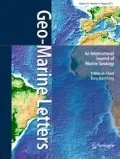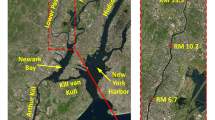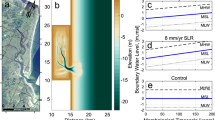Abstract
Under stable sea level conditions, estuaries tend to accumulate sediment resulting in changes that can be conceptualised as a progression from a juvenile system to maturity. Sea level rise results in an increase in accommodation space within the estuary that can effectively reverse the progression towards maturity. This effect was investigated for Tairua Estuary, New Zealand, using a set of MIKE 21 HD (hydrodynamic) and MIKE 21 ST (sediment transport) numerical models forced by tides, wind and fluvial discharges. A range of scenarios of sea level rise and changing fluvial inputs were simulated. The simulation results predicted a general trend of increasing tidal range with sea level rise, which was partially offset by higher fluvial discharges within high fluvial input scenarios. Under present conditions, the estuary is ebb-dominated with predominantly fluvial inputs, but with increasing sea level, the estuary becomes increasingly flood-dominant and the transition from fluvial to marine sediments within the estuary progressively moves landward. If the sediment supply increases in tandem with the accommodation space, the result would be no significant change to the estuary’s hydrodynamics and sediment transport patterns. Under present conditions, observations and modelling indicate that sediment is exported by ebb-dominant conditions, suggesting a capacity to compensate for increasing accommodation space. However, modelling indicates a sediment deficit at higher projected sea levels, resulting in sediment being scavenged from the seaward margin of the sandy barrier spit enclosing the estuary. Scavenging would increase the coastal erosion hazard for the residents of the barrier spit. This situation does not arise if the rate of increase in accommodation space remains below the annual fluvial sediment supply. Ultimately, our results show the importance of considering catchment-derived sediment supply and morphological complexity, when predicting how the changing hydrodynamics modulate the interplay between sediment stored within the estuary and the open coast, and determining the fate of the coast during sea level rise.






Similar content being viewed by others
References
Bell RG (1994) Behaviour of dissolved silica, and estuarine/coastal mixing and exchange processes at Tairua Harbour, New Zealand. N Z J Mar Freshw Res 28(1):55–68
Cahoon DR, Hensel PF, Spencer T, Reed DJ, McKee KL, Saintilan N (2006) Coastal wetland vulnerability to relative sea-level rise: wetland elevation trends and process controls. In: Verhoeven JT, Beltman B, Bobbink R, Whigham DF (eds) Wetlands and natural resource management. Ecological studies (analysis and synthesis), Volume 190. Springer, Berlin, pp 271–292
Carrasco AR, Ferreira Ó, Roelvink D (2016) Coastal lagoons and rising sea level: a review. Earth Sci Rev 154:356–368
Chen R, Twilley RR (1998) A gap dynamic model of mangrove forest development along gradients of soil salinity and nutrient resources. J Ecol 86:37–51
Church JA, White NJ (2011) Sea-level rise from the late 19th to the early 21st century. Surv Geophys 32:585–602
Clement AJH, Whitehouse PL, Sloss CR (2016) An examination of spatial variability in the timing and magnitude of Holocene relative sea-level changes in the New Zealand archipelago. Quat Sci Rev 131:73–101
Dalrymple RW, Zaitlin BA, Boyd R (1992) Estuarine facies models; conceptual basis and stratigraphic implications. J Sediment Res 62:1130–1146
DHI, 2017, MIKE 21 Flow Model& MIKE 21 Flood Screening Tool, Hydrodynamic Module, Scientific Documentation, 53 pp., http://manuals.mikepoweredbydhi.help/2017/Coast_and_Sea/M21HDFST_Scientific_Doc.pdf
Drylie TP, Lohrer AM, Needham HR, Bulmer RH, Pilditch CA (2018) Benthic primary production in emerged intertidal habitats provides resilience to high water column. J Sea Res 142:101–112
Felsing M, Giles H (2011) Tairua Estuary shellfish and benthic habitat mapping and assessment of sediment contamination (2009/10), Waikato Regional Council Technical Report 2011/31, Hamilton: Waikato Regional Council, 62 pp.
Gibb JG, Aburn JH (1986) Shoreline fluctuations and an assessment of a coastal hazard zone along Pauanui Beach, Eastern Coromandel Peninsula, New Zealand Water and Soil Technical Publication 27, 48 pp.
Godoi VA, Bryan KR, Gorman RM (2016) Regional influence of climate patterns on the wave climate of the southwestern Pacific: the New Zealand region. J Geophys Res Oceans 121(6):4056–4076
Hannah, J. and Bell, R. G., 2012. Regional sea level trends in New Zealand, Journal of Geophysical Research: Oceans, 117(C01004), https://doi.org/10.1029/2011JC007591
Hayward B, Morley M (2014) Is Coromandel Peninsula rising? Journal of Auckland Geoclub: Geocene 11:22–23
Hemer MA, Church JA, Hunter JR (2010) Variability and trends in the directional wave climate of the Southern Hemisphere. Int J Climatol 30(4):475–491
Hicks DM, Shankar U, McKerchar AI, Basher L, Jessen M, Lynn I, Page M (2011) Suspended sediment yields from New Zealand rivers. J Hydrol (NZ) 50(1):81–142
Hong B, Shen J (2012) Responses of estuarine salinity and transport processes to potential future sea-level rise in the Chesapeake Bay. Estuar Coast Shelf Sci 104–105:33–45
Hume TM, Gibb JG (1987) The “wooden-floor” marker bed—a new method of determining historical sedimentation rates in some New Zealand estuaries. J Roy Soc New Zeal 17(1):1–7. https://doi.org/10.1080/03036758.1987.10421703
Hume TM, Herdendorf CE (1988) A geomorphic classification of estuaries and its application to coastal resource management—a New Zealand example. Ocean Coast Manag 11:249–274. https://doi.org/10.1016/0951-8312(88)90022-7
Hume TM, Snelder T, Weatherhead M, Liefting R (2007) A controlling factor approach to estuary classification. Ocean Coast Manag 50:905–929
Hunt S (2019) Summary of historic estuarine sedimentation measurements in the Waikato region and formulation of a historic baseline sedimentation rate Waikato Regional Council Technical Report 2019/18. 30 pp
Kennedy DM (2008) Recent and future higher sea levels in New Zealand: a review. NZ Geog 64:105–116. https://doi.org/10.1111/j.1745-7939.2008.00132.x
Kieft RL, Hampson GJ, Jackson CA-L, Larsen E (2011) Stratigraphic architecture of a net-transgressive marginal- to shallow-marine succession: Upper Almond Formation, Rock Springs Uplift, Wyoming, U.S.A. J Sediment Res 81:513–533
Kirwan ML, Temmerman S, Skeehan EE, Guntenspergen GR, Fagherazzi S (2016) Overestimation of marsh vulnerability to sea level rise. Nat Clim Chang 6:253–260
Liu Z (2014) Hydrodynamic and sediment transport numerical modelling and applications at Tairua Estuary, New Zealand. PhD Thesis, University of Waikato, Hamilton. 306 pp
Liu C, de Lange W, Winter C, Bryan KR (2011) Forcing mechanisms of a seiching event at Tairua Estuary, New Zealand. In 20th Australasian Coastal and Ocean Engineering conference and the 13th Australasian Port and Harbour Conference (pp. 1–6). Conference held at Perth, Western Australia: EECW Pty Ltd
Lopes JF, Dias JM (2007) Residual circulation and sediment distribution in the Ria de Aveiro lagoon, Portugal. J Mar Syst 68:507–528
Lorenzo-Trueba J, Ashton AD (2014) Rollover, drowning and discontinuous retreat: distinct modes of barrier response to sea-level rise arising from a simple morphodynamic model. J Geophys Res: Earth Surf 119(4):779–801. https://doi.org/10.1002/2013JF002941
Masselink G, Hughes MG, Knight J (2011) Coastal processes and geomorphology. 2nd edn. Hodder Education, London, p 416
Ministry for the Environment (2008) Coastal hazards and climate change. A guidance manual for local government in New Zealand. 2nd edition. Ministry for the Environment, Wellington, p 127
Ministry for the Environment (2017) Coastal hazards and climate change: guidance for local government. Ministry for the Environment, Wellington, p 279
Ministry for the Environment (2018) Climate change projections for New Zealand: atmosphere projections based on simulations from the IPCC fifth assessment, 2nd Edition. Ministry for the Environment, Wellington, p 131
National Research Council (1987) Responding to changes in sea level: engineering implications. The National Academies Press, Washington, DC, p 160
Nicholls RJ, Hoozemans FMJ, Marchand M (1999) Increasing flood risk and wetland losses due to global sea-level rise: regional and global analyses. Glob Environ Chang 9(1):S69–S97. https://doi.org/10.1016/S0959-3780(99)00019-9
Palmer K, Watson C, Fischer A (2019) Non-linear interactions between sea-level rise, tides, and geomorphic change in the Tamar Estuary, Australia. Estuar Coast Shelf Sci 225
Sheffield AT, Healy TR, McGlone MS (1995) Infilling rates of a steepland catchment estuary, Whangamata, New Zealand. J Coast Res 11(4):1294–1308
Sinha PC, Rao YR, Dube SK (1997) Effect of sea-level rise on tidal circulation in the Hooghly Estuary, Bay of Bengal. Mar Geod 20(4):341–366
Smith, R.K., and Bryan., K.R., (2007). Monitoring Beach Volume Using a Combination of Intermittent Profiling and Video Imagery. Journal of Coastal Research, 23(4), 892–398. https://doi.org/10.2112/04-0287.1
Townend I, Pethick JS (2002) Estuarine flooding and managed retreat. Philos T R Soc A 369(1796):1477–1495. https://doi.org/10.1098/rsta.2002.1011
Van Maanen B, Coco G, Bryan KR, Friedrichs CT (2013) Modelling the morphodynamic response of tidal embayments to sea level rise. Ocean Dyn 63(11–12):1249–1262
Van Rijn LC, Walstra DJR, Grasmeijer B, Sutherland J, Pan S, Sierra JP, (2002) Simulation of nearshore hydrodynamics and morphodynamics on the time scale of storms and seasons using process-based profile models. In: Van Rijn LC (Ed.) The behaviour of a straight sandy coast on the time scale of storms and seasons: process knowledge and guidelines for coastal management. March 2002. EC MAST Project, MAS3-CT97-0086, pp. S1–S33.
Winter C (2007) On the evaluation of sediment transport models in tidal environments. Sediment Geol 202(3):562–571. https://doi.org/10.1016/j.sedgeo.2007.03.019
Acknowledgements
This study was conducted jointly by the University of Waikato and the Waikato Regional Council, New Zealand. Model development was supported by DHI Water & Environment, ASR Marine and Freshwater Consultants Ltd. and MARUM, University of Bremen, Germany. Prof. Christian Winter hosted the INTERCOAST research stay at Marum of Cathy Liu where Cathy set up and calibrated an initial version of the numerical model. NIWA supplied the tidal data for offshore model boundaries. We thank the two anonymous reviewers for their helpful comments.
Funding
Cathy Liu was funded by the Waikato Regional Council and a scholarship from the University of Waikato.
Author information
Authors and Affiliations
Corresponding author
Additional information
Publisher’s note
Springer Nature remains neutral with regard to jurisdictional claims in published maps and institutional affiliations.
Rights and permissions
About this article
Cite this article
Liu, Z.C., de Lange, W.P. & Bryan, K.R. Estuary rejuvenation in response to sea level rise: an example from Tairua Estuary, New Zealand. Geo-Mar Lett 40, 269–280 (2020). https://doi.org/10.1007/s00367-019-00603-0
Received:
Accepted:
Published:
Issue Date:
DOI: https://doi.org/10.1007/s00367-019-00603-0




